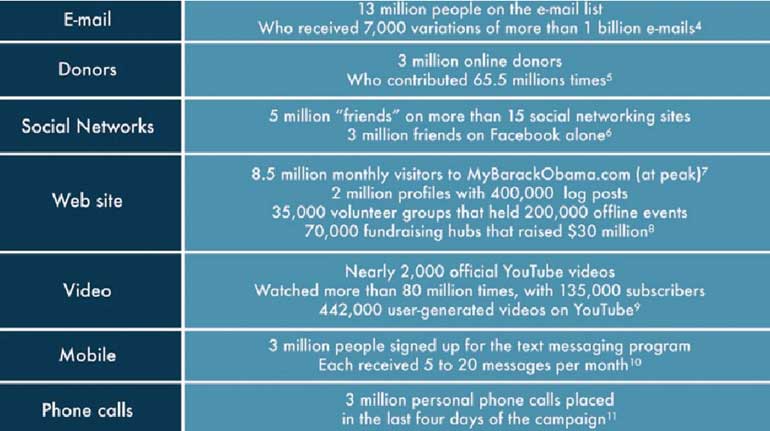Sunday Dec 21, 2025
Sunday Dec 21, 2025
Thursday, 23 July 2015 00:00 - - {{hitsCtrl.values.hits}}

Again election time has come. We can see many promises to Government servants, farmers, business people and those from all over the country. We can see a lot of “breaking news” in the media.
For the people it is all about “new developments” in the political scenario. If you go to workplaces, you can see many hours being wasted talking about politics and it is worth assessing “talking politics in office and productivity”.
The middle class in Sri Lanka rarely get “entertainment” because of their busy lifestyles with fast food and cholesterol. Anyway, now this year they are getting most wanted entertainment frequently by watching debates on TV!
But again we have to research the male-female TV watching ratio as I think it is husbands who are willing to get satisfaction by watching political debates than their wives.
History
Anyway political parties working really hard to ‘market’ their candidates and policies. Especially once it comes to the general election with the war for preferential votes, there is a need for better marketing for individuals as well. In this context it is important to discuss the concept of ‘political marketing’.
Like with other subjects we have the history of political marketing. Kelly(1956) first defined the term of ‘political marketing’ to refer the same domain of activity. This has been further developed by Rothschild’s (1978) who has his research work in effectiveness of political advertising and segmentation.
Then the area of political marketing has been developed by many experts and the work of Newman and Sheth (1985) and O’Shaughnessy (1990) with the pivotal work ‘Phenomenon of Political Marketing,’ which can be considered as important in this context. Further, ‘The Handbook of Political Marketing’ (Newman, 1999), Harris and Lock’s ‘Review of Political Lobbying in the UK’ and Butler and Harris’ (2009) ‘Review of Political Marketing Theory’ also should be mentioned as significant contributions for the subject
Political marketing with social media
What is political marketing? It is important to understand the concept. Political marketing is a fundamental part of political life. Presidents and prime ministers; politicians and parties; government departments and councils all use marketing in their pursuit of political goals. So this is common for all.
Recently it can be seen that social media has emerged as one of the effective methods in political marketing. According to Okan and Akyuz (2015), social media campaigns should be used in an efficient way through reaching volunteers and increasing their shares on the platforms for the multiplier effect.
They were of the view that the campaigns created by political candidates and parties were easily accessible to the target audience through social media platforms, thus marketing activities can be managed with voter reviews in a more interactive way. The table showcases how Barak Obama has used social and digital media to win over the masses in the US.
What is ‘product’ in political marketing?
‘Core product’ is the main and central pillar of the product. This has described by Brassington and Pettitt (1997) as ‘the heart of the product, the main reason for its existence…’ In terms of political marketing, this may be viewed as the basic ideology upon which all aspects of a political party are grounded and is central to its very being (Lloyd, 2005).
This is go in line with the main themes of political parties and their vision, mission, etc. Assume the Hela Urumaya started with protecting one segment of voters (say Sinhala Buddhists) and then they are deviating their main objectives, then we can see the myopic situation which is deviating from their main ‘product’.
Mahinda and UPFA
It can be observed that Mahinda Rajapaksa, the former President of Sri Lanka who is contesting in Kurunegala District, and other candidates from various districts display his photo with their own in their individual campaigns. According to Harris (2001) ‘personalisation’ of politics has led to a situation in which the party leader is at the centre of its brand image (Lock and Harris 1996). But again we have to question this argument as in the Sri Lankan context, the former President is not the leader of the UPFA (I think that in this 2015 general election we can see many exceptions and fantasies and more importantly this is important for researchers in business and social research).
Marketing mix
Usually in marketing we discuss marketing mix. This is all about ‘strategies to satisfy customers’. It consists of 4Ps (or 7Ps). Interestingly Lloyd (2005) has created the ‘political marketing mix’ by incorporating the research work done by scholars such as Borden (1962), Booms and Bitner (1981) and Beaven and Scotti (1990).

Political marketing mix
“The first of the components involves the ‘services offering’ afforded by the political party. At the broadest level this includes policy on the management of national security, social stability and economic growth. However, in cases where the party of government takes on a visible management role, the Millennium Dome being a case in point, they also acquire specialist project management roles. Electors judge the suitability of a party not only on their electoral policies, but also as to whether they feel they have the ability to fulfil their responsibilities. Consequently, political parties must ensure that they have appropriate management skills and expertise.
“The second component is that of ‘representation.’ This involves the way that all aspects of the political party, its policies and its members are represented to the electorate. This goes further than purely ‘communication’ or ‘promotion’ because it takes into account both the controllable aspects of political activity such as policy statements and briefings, public appearances and political advertising and PR, and the uncontrollable elements such as media coverage. Electors consult their mental ‘scripts’ to match expectation to representation. If a match occurs, the representation will serve to reinforce the existing perception of the political ‘product.’ In contrast, a mismatch will result in dissonance and a resulting alteration of the mental ‘script.’
“The implications of ‘representation’ for the political product are three-fold. Firstly, in light of recent allegations of ‘sleaze’ within the political sphere, any dubious activity observed on the part of a politician is likely to be viewed with distrust on the part of the electorate. Therefore, politicians must not only maintain their integrity, they must be seen to display integrity if electors’ ‘scripts’ are ever to be modified. Secondly, all aspects of the party must be represented in a realistic way. If electors are allowed to acquire unrealistic expectations on the basis of representation, the inability to deliver will only result in disappointment and distrust. Finally, in the event that the political ‘product’ is misrepresented in the media, the way that it is seen to respond through controllable elements can not only minimise the damage, but actually enhance the image of the ‘political product.’
“Accommodation is the third component to be taken into account in the formulation of the political marketing mix. It highlights the requirement on the part of political parties to understand the needs of the electorate and be able torespond to them appropriately. This does not mean, however, that political parties should simply become ‘focus-group lead.’ Instead, parties should attain an understanding of public priorities and public interest and be prepared to address these topics on the basis of their ‘core product’ or ideology. During the 20q01 election, there was much criticism of the strategy adopted by the Conservative Party and their decision to focus upon Europe, perceived as a Labour Party weakness, rather than deal in detail with issues such as the NHS and education. According to one caller to a BBC Radio 5 phone-in, they had simply “lost the plot.” In addition, Beaven and Scotti (1990) also cite Webster’s Dictionary definition of ‘accommodation’ as ‘something supplied for convenience.’ In terms of the political market, electors must be able to access it and ideally participate within it with some degree of ease. Members of parties, MPs and members of the Government should be seen as accessible and open, whilst participation at all levels should be both encouraged, and seen to be encouraged, across all sections of the community. Central to this notion is the requirement that those participating should feel that they have (and be seen to have) some degree of influence. Without this, potential participants will question the point of expending time and effort doing so. At a time when we are looking at an ever more presidential-style system of government, the need for accommodation becomes all the more acute.
“‘Investment,’ the fourth component, can take a number of forms. Unlike the term ‘outlay’ (Beaven and Scotti 1990) or ‘price’ (Borden 1962, Booms and Bitner 1981), the term ‘investment’ relates more directly with the stakeholdertype relationship that the electorate has with its political representatives. ‘Investment’ can be a direct financial payment in the form of subscriptions or donations to a political party or candidate. However, it can also take the form of a delayed financial ‘investment,’ for example, likely changes in tax or welfare benefits or changes in the standard of living. Alternatively, ‘investment’ can also take the form of less financially based factors such as the time and effort to participate (Beaven and Scotti 1990) and the emotional and experiential aspects (Dermody and Scullion 2001) attached to participation within the political process. Whatever the form, electors expect to see a return, either tangible or intangible.
“The final component of the political marketing mix is that of ‘outcome.’ The ability to deliver upon policy issues and election promises is one of the most tangible ways by which electors judge the performance of political parties. However, it is not just the final outcome that counts, but also how that outcome is achieved. For example, according to a BBC Online report (Health Doubts Raised over Hospital Waiting Lists, 1/9/99) patients were being dropped from hospital waiting lists in order to meet government targets. Therefore, political parties should be seen to deliver upon their promises effectively, efficiently and ethically.”
– Political Marketing Mix by Jenny Lloyd
One might argue that the party which can really utilise the concept can win the hearts of the people. Anyway again it can be questioned that how effectively we can use the concepts such as ‘political marketing mix’ in a Sri Lankan context with the different socio economic and cultural environment in the country. Furthermore, as mentioned earlier, the abnormal political environment also can be one of the key factors in the upcoming election.
Selected references
Butler, P. and Harris, P. (2009), “Considerations on the evolution of political marketing theory”, Marketing Theory, Vol. 9 No. 2, pp. 149‐64.
Harris, P. and Lock, A. (2002), “Sleaze or clear blue water? The evolution of corporate and pressure group representation at the major UK party conferences”, Journal of Public Affairs, Vol. 2 No. 3, pp.136‐51
Kelley, S. Jr (1956), Professional Public Relations and Political Power, John Hopkins University Press,Baltimore, MD
Lloyd J.(2005) Square Peg, Round Hole? Can Marketing-Based Concepts Such as the ‘Product’ and the ‘Marketing Mix’ Have a Useful Role in the Political Arena?, Journal of Nonprofit & Public Sector Marketing, 14:1-2, 27-46
Newman, B.I. (Ed.) (1999), Handbook of Political Marketing, Sage, London
Newman, B.I. and Sheth, J.N. (1985), “A model of primary voter behaviour”, Journal of Consumer Research, Vol. 12 No. 2, pp. 178‐87.
O’Shaughnessy, N.J. (1990), Phenomenon of Political Marketing, Macmillan, Basingstoke.
Rothschild, M.L. (1978), “Political advertising: a neglected policy issue in marketing”, Journal of Marketing Research, Vol. 15 No. 1, pp. 59‐71